Budgets and public debt. – The main revenue of the Spanish budget derives from direct and indirect taxation and from monopolies. Expenditure includes those for public debt service, public works, national defense, education and pensions.
The analysis of the above figures cannot lead to conclusions corresponding to the actual financial situation in Spain if the development of the public debt is not taken into account at the same time. To cover up the moronsIn fact, there was a wide recourse to the issuance of treasury bonds, especially during the first years of the dictatorship, in which almost all the tax reforms attempted by the government failed due to the protests aroused and it was therefore not possible to meet the extraordinary expenses with a increase in tax revenues. A public debt amortization fund, with its own funds, was created in 1926, but even its result can be said to have been almost nil. When, in 1927, it was therefore necessary to proceed with a consolidation of the floating debt, the figure of the consolidated public debt (both perpetual and amortizable) was suddenly inflated by 5.6 billion (from 12,050 at the end of 1926 to 18,304 at the end of 1927 ). The liquidation of the financial management of the dictatorship can be said to have been completed in the years 1930, 1931 and 1932, in which the expenses were reduced to the maximum and at the same time provision was made to pay the outstanding commitments. Most of the taxes were therefore increased; however, the worsening of the economic crisis did not allow for an increase in revenues in line with forecasts. For Spain public policy, please check petsinclude.com.
In order to evaluate the actual results of the last few years, it must be borne in mind that the ascertained revenues also include the proceeds of public loans, so that the budget effectively closed with increasing deficits from 1931 onwards.
At the end of 1935 the public debt had risen overall to 21,779 million, of which 917 of foreign debt and 1,940 of floating. We also recall that in 1933, on the basis of articles 16 and 17 of the constitution of September 15, 1932, the Generalidad of Catalonia had its own budget.
Money and credit. – The monetary unit is the peseta divided into 100 céntimos, whose face value is still equal to that of the pre-war French franc. In reality, however, having abandoned the gold base during the World War, the peseta devalued strongly and its stabilization due to the various complications of internal politics has not yet been carried out, despite the fact that the government has repeatedly taken this path in recent years. (interventions on the foreign exchange market starting from 1924, appointment of a committee of experts in 1928, elaboration in 1931 of a stabilization plan to be implemented with the assistance of the Bank for International Settlements, etc.). Starting in 1931, as a consequence, first of all of international speculation, and then above all of the increasingly serious internal situation, the devaluation of the peseta was even more accentuated.
Circulation is made up almost exclusively of notes from the Bank of Spain: an institution that has the privilege of issuing (the agreement with the government was extended for 25 years on 1 January 1922), as well as the obligation to free the treasury service and to pay part of its profits to the government under certain conditions. The bank is authorized to issue notes up to 5 billion and, only with the consent of the government, up to the maximum limit of 6 billion pesetas, and must cover this circulation with a metal reserve of 45% (40% in gold) for the former. four billion and 60% (50% in gold) for the last two. At the end of June 1936, notes in circulation amounted to 5,455 million pesetas and the metal reserve on the same date was 2,202 million in gold and 656 in silver.
The main credit institutions, besides Banco de España and Banco Hipotecario (which, having a monopoly on the issue of mortgage coupons, is also subject to the intervention of the state which appoints the governor), are Banco Central, Banco Hispano-Americano, Banco exterior de España, Banco Español de Credito, Banco de Bilbao, Banco de Vizcaya, and Banco Urquijo.
